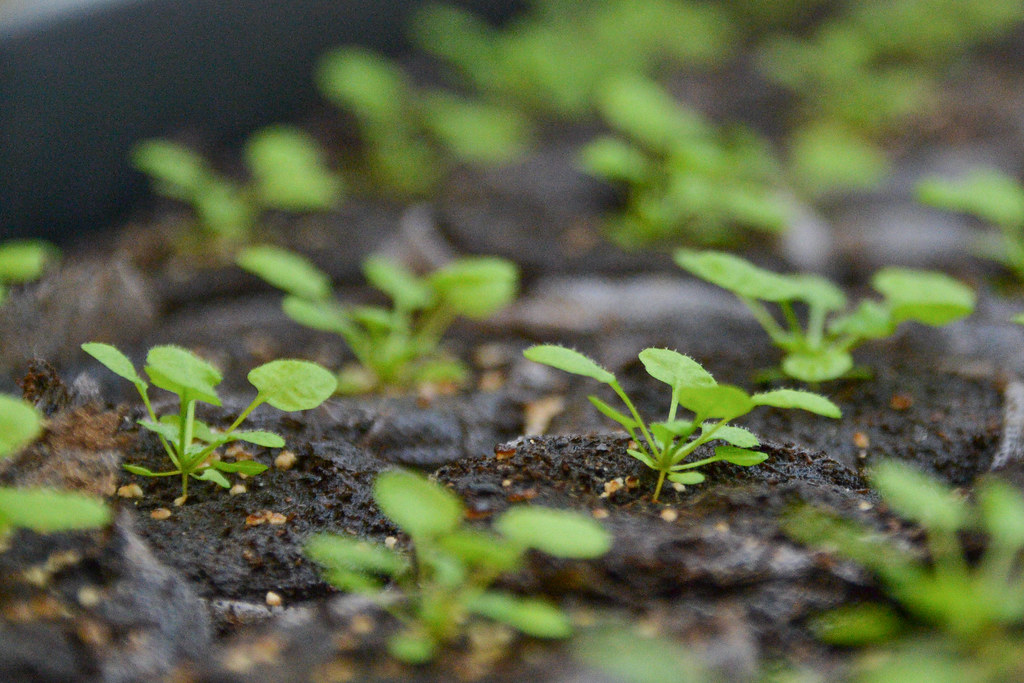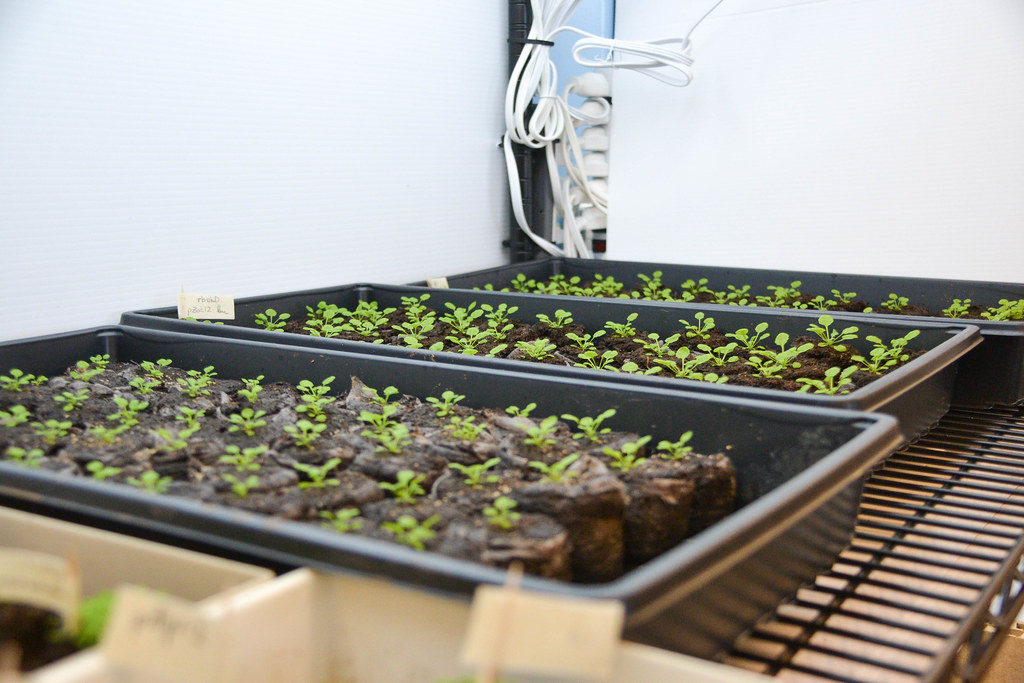Protein is important in balancing iron and reactive oxygen in plant and cancer cells
Arabidopsis growing in Ron Mittler’s lab. | photo by Becca Wolf, Bond LSC
By Becca Wolf | Bond LSC
You might tend to think durability is more of an issue in building a car or engineering a building, but environmental stress makes resilience vital for plants, too.
In the world of understanding and engineering more durable crops, scientists recently identified a protein that’s key to some of that resilience in a neat way. Actually, it’s literally a NEET protein.
Ron Mittler, a Bond Life Sciences Center principal investigator and professor of plant sciences and surgery, is probing the use of the NEET protein to balance iron and reactive oxygen species (ROS) in the chloroplast to make plants stronger and healthier, and it plays a similar role in cancer cells. These proteins belong to a unique family of iron-sulfur (Fe-S) proteins ideally maintaining the proper balance of the heavy metal in and outside of plant cells. Along with several other scientists, Mittler published his most recent plant findings in The Plant Journal last October.
Since NEET proteins regulate both iron and ROS, Mittler teamed up with heavy metal expert David Mendoza, fellow Bond LSC primary investigator and associate professor of plant sciences. Through a Bond LSC Grant for Innovative Collaborative Research, the two started work at the intersection of two labs.
“The main philosophy of Bond LSC is to establish collaborations between researchers to advance the field of whatever sciences that you do,” Mendoza said.
Mittler and Mendoza looked at how NEET impacts iron and ROS, working together to figure out how to make plants more durable. Doing so, they have made a lot of progress in the field and believe that their collaboration has been a good one. Says Mendoza, “It is a very productive collaboration.”
Trays of Arabidopsis in Ron Mittler’s lab. | photo by Becca Wolf, Bond LSC
A Balancing Act
But the work doesn’t stop with plants. Mittler found NEET proteins also play a similar role in cancer cells, regulating the level of iron and potentially toxic ROS compounds. Humans and plants need iron and ROS, but too much of either can be destructive. NEET proteins allow cells to grow and spread quickly which is beneficial for plants, but detrimental for humans when cancers grow out of control. In humans, NEET proteins also play a significant role metabolism related to diabetes and progression of neurodegenerative diseases.
Despite needing both iron and ROS to function, there can be too much of a good thing. To keep iron levels balanced, oxygen is needed. While oxygen on its own is a fairly stable molecule, adding electrons or exciting the present electrons can make the molecule want to react with things around it creating oxidants. Electrons are the negatively charged particles of an atom that keep balance within the cell. When balanced, iron and ROS helps cells grow, but when placed together, the iron turns ROS into hydroxyl radical, an ion that reacts with anything and destroys everything. If not controlled, this desire to bond with things nearby can damage cells and lead to cancer.
Cancer cells like ROS and iron because it enables them to spread quickly and take over more of the body. To stay balanced, NEET proteins are needed.
“These proteins apparently enable the cells to keep high levels of both iron and ROS and to survive,” says Mittler, “So it looks like cancer needs these proteins because if you suppress these proteins or if you target them with drugs, the cancer cells die.”
Sara Zandalinas holding a dying Arabidopsis seedling and a living seedling in Ron Mittler’s lab. | photo by Becca Wolf, Bond LSC
Poisoning the cell
Knowing NEET proteins make cancer and plant cells stronger, Mittler wanted to look at “what happens if they’re not functioning well,” in hopes to understand their function. To test this, Mittler and his collaborators found a way to make the NEET proteins not function. Mittler called this “poisoning the cell.”
“If there is no protein, there’s no life,” he states. “We were able to control when we introduce this protein, and being able to introduce this protein enabled us to actually find out what happened to the cell if this protein goes bad.”
It was found that if the function of this protein is disrupted, the chloroplast is destroyed. Mittler described it as “completely blown to pieces.” The destruction of the chloroplast is caused by too much iron due to a broken NEET protein. Similarly in cancer cells, if there are no NEET proteins, the cells do not spread as quickly and die.
Mittler elaborated, “What we found is that we can target those proteins in cancer, so then we basically destroy the cancer cells.” Currently, NEET proteins are used as markers in the cancer field. Doctors and scientists look for them in order to help diagnose patients and to figure out life expectancy rates. But in the future, doctors hope to use targets these proteins to kill off cancer cells, a treatment that would be less toxic than chemotherapy.
In plants, Mittler has concluded that the NEET protein would make them grow bigger and faster, leading plants to be “more tolerant to stresses because it has the ability to modulate the levels of iron and reactive oxygen.” Findings like these may one day help plants deal with stress like drought and temperature extremes. With humans continuing to contaminate the environment and climate change escalating conditions, Mittler hopes his findings on iron, ROS, and NEET proteins will make plants able to withstand changes better.
“If I can improve the way plants balance reactive oxygen and iron, I can make plants tolerate much more of these bad combinations of stresses even, and maybe even make bigger, stronger, healthier plants.”
Read more about this research in the October 2019 edition of The Plant Journal article “Expression of a dominant‐negative AtNEET‐H89C protein disrupts iron–sulfur metabolism and iron homeostasis in Arabidopsis.”
The Bond LSC Grant for Innovative Collaborative Research program aims to foster inter-laboratory collaboration to make pilot projects that have potential for later federal funding.




